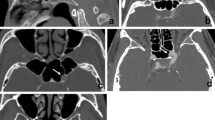Abstract
Accidental injury of the internal carotid artery (ICA) remains one of the most challenging complications reported in the endoscopic endonasal transsphenoidal approaches (EETA) particularly, in sphenoid sinuses with ill-defined carotid bony landmarks. The purpose of this study was to describe an anatomical model for the endoscopic orientation of juxta-pituitary segment of ICA in relation to the lateral optico-carotid recess (OCR) as a nearby bony landmark. Cadaveric dissection was conducted progressively in twenty fresh adult cadavers simulating the EETA. After reducing posterior and lateral walls of sphenoid sinuses, various measurements were taken from both lateral OCRs to "contact points" of the juxta-pituitary segment of ICA and lateral margins of the pituitary gland. Current results have enabled us to divide the region between lateral OCRs into three compartments. Two lateral parasellar compartments contain juxta-pituitary segments of ICA showing a mean width of 8 mm; with a narrow range of 7–10 mm; and a central inter-carotid sellar compartment represents the safe region for bone drilling showing widely variable widths ranging between 9 to 20 mm. In all specimens; variation in the width of the inter-carotid compartment correlated with the distance between both lateral OCRs. This study improves surgeons’ awareness of the ICA course variations in the EETA through sphenoid sinuses with ill-defined bony landmarks. An appreciation of the measurements gathered from this study can help in operative training, and can also provide a base for future studies to confirm ICA courses associated with higher risk of injury.




Similar content being viewed by others
References
Cavallo LM, Messina A, Cappabianca P et al (2005) Endoscopic endonasal surgery of the midline skull base: anatomical study and clinical considerations. Neurosurg Focus 19:1–14
Cappabianca P, de Divitiis E (2003) Endoscopic endonasal transsphenoidal surgery Management of Pituitary Tumors. Springer, Berlin, pp 161–171
Liu JK, Das K, Weiss MH, Laws ER Jr, Couldwell WT (2001) The history and evolution of transsphenoidal surgery. J Neurosurg 95:1083–1096
McDonald T, Laws Jr E (1982) Historical aspects of the management of pituitary disorders with emphasis on transsphenoidal surgery. The Management of Pituitary Adenomas and Related Lesions with Emphasis on Transsphenoidal Microsurgery. Appleton-Century-Crofts, New York, pp 1–13
Gardner PA, Tormenti MJ, Pant H, Fernandez-Miranda JC, Snyderman CH, Horowitz MB (2013) Carotid artery injury during endoscopic endonasal skull base surgery: incidence and outcomes. Oper Neurosurg 73(2):ons261–ons270
Laws ER (1999) Vascular complications of transsphenoidal surgery. Pituitary 2(2):163–170
DePowell JJ, Froelich SC, Zimmer LA et al (2014) Segments of the internal carotid artery during endoscopic transnasal and open cranial approaches: can a uniform nomenclature apply to both? World Neurosurg 82:S66–S71
Labib MA, Prevedello DM, Carrau R, Kerr EE, Naudy C, Abou Al-Shaar H et al (2014) A road map to the internal carotid artery in expanded endoscopic endonasal approaches to the ventral cranial base. Oper Neurosurg 10(3):448–471
Hamberger C, Hammer G, Marcusson G (1960) Experiences in transantrosphenoidal hypophysectomy. Transactions of the Pacific Coast Oto-Ophthalmological Society Annual Meeting, pp 273–286
Kassam AB, Prevedello DM, Carrau RL, Snyderman CH, Thomas A, Gardner P, Zanation A, Duz B, Stefko ST, Byers K, Horowitz MB (2011) Endoscopic endonasal skull base surgery: analysis of complications in the authors’ initial 800 patients: a review. J Neurosurg 114(6):1544–1568
Solares CA, Ong YK, Carrau RL, Fernandez-Miranda J, Prevedello DM, Snyderman CH, Kassam AB (2010) Prevention and management of vascular injuries in endoscopic surgery of the sinonasal tract and skull base. Otolaryngol Clin North Am 43(4):817–825
Chin OY, Ghosh R, Fang CH, Baredes S, Liu JK, Eloy JA (2016) Internal carotid artery injury in endoscopic endonasal surgery: a systematic review. Laryngoscope 126(3):582–590
Unlu A, Meco C, Ugur H, Comert A, Ozdemir M, Elhan A (2008) Endoscopic anatomy of sphenoid sinus for pituitary surgery. Clin Anat 21:627–632
Renn WH, Rhoton AL Jr (1975) Microsurgical anatomy of the sellar region. J Neurosurg 43:288–298
Abuzayed B, Tanriover N, Ozlen F et al (2009) Endoscopic endonasal transsphenoidal approach to the sellar region: results of endoscopic dissection on 30 cadavers. Turk Neurosurg 19:237–244
Isolan GR, de Aguiar PHP, Laws ER, Strapasson ACP, Piltcher O (2009) The implications of microsurgical anatomy for surgical approaches to the sellar region. Pituitary 12:360–367
Cebula H, Kurbanov A, Zimmer LA (2014) Endoscopic, endonasal variability in the anatomy of the internal carotid artery. World Neurosurg 82:e759–e764
Yilmazlar S, Kocaeli H, Eyigor O, Hakyemez B, Korfali E (2008) Clinical importance of the basal cavernous sinuses and cavernous carotid arteries relative to the pituitary gland and macroadenomas: quantitative analysis of the complete anatomy. Surg Neurol 70:165–174
Citardi MJ, Batra PS (2007) Intraoperative surgical navigation for endoscopic sinus surgery: rationale and indications. Curr Opin Otolaryngol Head Neck Surg 15:23–27
Funding
The authors declare that they have no funding resources.
Author information
Authors and Affiliations
Corresponding author
Ethics declarations
Conflict of interest
The authors declare that they have no conflict of interest.
Additional information
Publisher's Note
Springer Nature remains neutral with regard to jurisdictional claims in published maps and institutional affiliations.
Rights and permissions
About this article
Cite this article
Ismail, M., Darwish, M., Gomma, M. et al. Endoscopic Orientation of Juxta-Pituitary Carotid in Transsphenoidal Approaches: Critical Considerations for Clinical Applications. Indian J Otolaryngol Head Neck Surg 73, 461–466 (2021). https://doi.org/10.1007/s12070-021-02454-7
Received:
Accepted:
Published:
Issue Date:
DOI: https://doi.org/10.1007/s12070-021-02454-7




